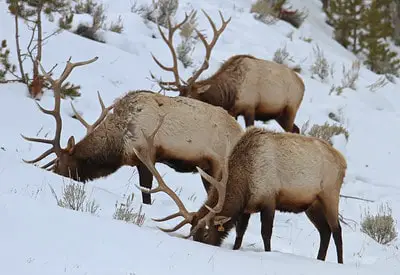This page of Wyoming hunting seasons is updated annually. While Thepredatorhunter.com focuses on coyotes, fox, and bobcats, it is hoped other game hunters will take up predator hunting as well. We suggest you check out these predator hunting links specific to the state of Wyoming:
Purchase a hunting license in Wyoming here.
Learn the rules for hunting coyotes in Wyoming.
Learn the rules for hunting bobcats in Wyoming.
Learn the rules for hunting fox in Wyoming.

Wyoming has an interactive hunt planner. Every animal, every zone, and every season is easily located and contains the most up-to-date information.
Wyoming hunting seasons for deer.
Wyoming Deer Seasons
| Archery Season* | Sept. 1-Sept. 30 |
| Season Dates* | Nov. 1 – Nov. 20 |
- Wyoming has many zones and seasons for deer. Check your specific zone and dates here.
Wyoming hunting seasons for antelope.
| Archery Season* | Aug 15 to Sep. 30th |
| Season Dates* | Oct. 1 – Nov. 20 |
- Wyoming has many zones and seasons for antelope. Check your specific zone and dates here.
Wyoming hunting seasons for elk.
| Archery Season* | Sept. 1-Sept. 30 |
| Season Dates* | Oct. 13 – Nov. 20 |
- Wyoming has many zones and seasons for elk. Check your specific zone and dates here.
Wyoming Moose hunting seasons.
| Archery Season* | Sept. 1-Sept. 30 |
| Season Dates* | Oct. 1 – Oct. 31 |
- Wyoming has many zones and seasons for moose. Check your specific zone and dates here.
Wyoming Bighorn sheep hunting seasons.
| Archery Season* | Aug 15-31 |
| Season Dates* | Sep 1 – Oct 31 |
- Wyoming has many zones and seasons for bighorn sheep. Check your specific zone and dates here.
Wyoming hunting seasons for Mountain Goat.
| Archery Season* | Aug 15-31 |
| Season Dates* | Sep 1 – Oct 31 |
- Wyoming has many zones and seasons for mountain goat. Check your specific zone and dates here.
Wyoming hunting seasons for black bear.
A very complicated season. Please check here to check for your zones and dates.
Bag Limits and Numbers of Licenses.
No person shall apply for or receive more than one (1) license for each big game species during any one (1) calendar year, except as otherwise provided in Commission Regulations. The maximum bag limit for big game animals and trophy game animals for any person with the proper licenses and permits shall not exceed the following number of animals: one (1) elk per license; one (1) moose per license; one (1) bighorn sheep per license; one (1) mountain goat per license; one (1) antelope per license; one (1) deer per license; one (1) black bear per license; one (1) mountain lion per license; one (1) gray wolf per license. Section 4 of this Chapter, Chapter 34, Depredation Prevention Hunting Seasons and other Commission regulations may provide for taking additional game animals with the proper licenses.
Open Hours for Taking Big Game, Small Game, Trophy Game, Upland Game Birds and Wild Turkey.
(a) Big game, trophy game and small game animals may only be taken from one-half (1/2) hour before sunrise to one-half (1/2) hour after sunset.
(b) Except as otherwise provided, upland game birds and wild turkey may only be taken from one-half (1/2) hour before sunrise to sunset.
Established Check Stations, Mandatory Reporting.
Every hunter, angler or trapper of furbearing animals shall stop and report at every check station on route to or from the hunting, fishing or trapping area regardless if the person has wildlife in possession. Upon request of any authorized Department representative, anyone who has been hunting, fishing or trapping shall produce a valid license and conservation stamp, if required and special management permit, if required, for game animals, game birds, furbearing animals or fish. Even if the game meat or fish in possession has been cut and wrapped or processed, the person transporting shall stop and report at the check station. Any person transporting wildlife harvested in another state or country shall stop at check stations on their route.
a) Check stations shall be signed and established at a point on a highway or road clearly visible at a distance of not less than two hundred (200) yards in either direction.
(b) Check stations shall be at a point where flashing warning lights shall be visible to oncoming traffic for a distance of not less than two hundred (200) yards. The emergency warning lights on a marked law enforcement vehicle or a yellow flashing light on a marked Department non-enforcement vehicle shall be in operation.
(c) At least one (1) person working the check station shall be in Department uniform.

